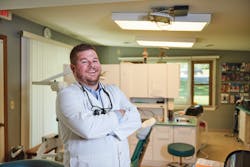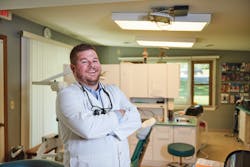After a $9,000 marketing ‘fail,’ this DE subscriber discovers a way to increase new patients by 349%
Joy Gendusa
First things first—I want to give kudos to all of you Dental Economics readers. By just reading this magazine (and yes, this article!), you’re doing a service to your practice and yourself. DE is the industry’s gold standard for educational content, and this article’s subject is proof positive of that.
Meet Kevin Tanty, DDS, of Waukesha, Wisconsin, a suburb of 70,000 located 20 miles outside of Milwaukee. Dr. Tanty is a client of mine, and his average new-patient numbers are up 349%—more than triple! But before we started working together, Dr. Tanty was a loyal DE reader, which is where he actually learned about the marketing plan that he would ultimately implement. So, this case study is as much about how much you learn as a DE reader as it is a testament to consistent, well-planned marketing.
Let’s get started and examine the three steps Dr. Tanty took to triple his new patients.
Kevin Tanty, DDS
Step 1: Always be learning and taking proactive measures—even if you lose $9,000.
Dr. Tanty’s dental career started in 2009, but let’s pick up his story in 2013. At the time, he was just leaving a practice he describes as “fizzling” to pick up an associateship two days a week at a much more successful practice—one owned by his former dental school instructor, Morgan Hamm, DDS. Dr. Tanty sensed that the fizzling practice would soon fizzle out, and he wanted to hedge his bets.
Dr. Tanty: “I started [working with Dr. Hamm] on a Wednesday, and I had a full schedule that Wednesday, and I had a full schedule on Friday, and I basically haven’t stopped since. It was a drastic change from the other office, where I would see a patient at 9:00 a.m. and then another at 3:00 p.m., and between those appointments I literally watched Netflix.”
Dr. Hamm’s practice operated on a business model right out of a bygone era—the day and age when dental services were not marketed. (I know plenty of dentists who still wish that were the case!)
Dr. Tanty: “Dr. Hamm ran a really, really successful practice that thrived, mostly, on word of mouth and the quality of the practice. He did not advertise or use marketing. He didn’t have a website. He didn’t even have a Google business listing. He had nothing!”
Dr. Tanty spent more than a year gaining experience with the opposite end of the success spectrum. On the one hand was a mismanaged and declining practice that Dr. Tanty prefers not to mention by name, and on the other, a thriving and well-oiled machine. When the time came for Dr. Hamm to retire and sell his practice, Dr. Tanty jumped at the opportunity. He purchased the practice in 2016 and went full-time in 2017.
Dr. Tanty: “Dr. Hamm had a huge reputation as a standup guy and a standup dentist. He was a local with a family name that held a lot of recognition in town. So when I took over, the practice was thriving.”
But could Dr. Tanty sustain it?
Dr. Tanty: “I understood that a lot of Dr. Hamm’s patients would likely leave after the transition. A lot of these patients had moved away years ago and still came to see Dr. Hamm out of loyalty, or they had other options closer to them. So I wanted to get ahead of that and get my name out there.”
He acted quickly, setting up a website and Google listing for the practice now known as Tanty Family Dental. But he knew that unless he wanted to end up like that other, unnamed and fizzling practice, he needed to do more. That meant marketing. He started with Yelp.
Dr. Tanty: “That was wasted money to the tune of about $9,000. I never once saw a single person say, ‘I saw you on Yelp.’”
Yikes! That’s when he remembered something very important.
Dr. Tanty: “I had for years seen your articles in Dental Economics, profiles of dentists who had tried direct mail and it was paying off. So I decided to take the leap [ . . . ]. And I have been very, very happy since then.”
Figure 1: Tanty Family Dental new patients per month, June 2016–July 2018
Step 2: Be consistent and go from averaging 4.9 new patients per month to 22.
Prior to starting his postcard marketing campaign, Dr. Tanty’s monthly new patient numbers had yet to reach double digits—but he was hardly twiddling his thumbs.
Dr. Tanty: “Deciding to change up our marketing was not a reactive thing. It wasn’t like, ‘Oh man, our schedules are getting light here.’ It was a proactive decision. I wanted to make sure that we had a steady stream of patients coming in at all times.”
What he didn’t expect was that his new patient numbers would double, then triple, and then some. From reading DE, Dr. Tanty felt confident that direct mail marketing could work—even if his colleagues weren’t so sure. A friend of his, who started a scratch practice not too far from Tanty Family Dental, sent out 6,000 postcards in a single drop to recruit new patients. The results, said Dr. Tanty, were underwhelming.
Dr. Tanty: “Her return was disappointing. It didn’t move the needle at all. And I knew, from reading your articles in Dental Economics, that you really have to hit a mailing list a minimum of three times before you start to see a return on it. So for me, that experience, plus what I saw at that fizzling practice, where they hired kids to hang pieces on doors and then said, ‘Direct mail never works,’ reinforced that you guys knew what you were talking about.”
Here is a breakdown of the campaign:
• Duration: Ongoing
• Mailing schedule: 6,000 postcards mailed every month
• Mailing list: Every resident on postal routes averaging $60,000 income living within a close radius of his practice
• Online integration: Automatic Google follow-up display ads with DirectMail2.0
Next, let’s look at Dr. Tanty’s average monthly new-patient numbers since taking over the practice:
• June 2016–July 2017 (before direct mail): 4.9 new patients per month
• Aug 2017–Aug 2018 (after direct mail): 22 new patients per month
• Result: 349% more new patients after starting a consistent postcard campaign
Is that amazing or what! And yes, postcard marketing was the lion’s share of Dr. Tanty’s marketing, accounting for over 85% of his entire marketing budget. (He spends about $10 per day on Google pay per click.) To see the change over time, let’s look at Dr. Tanty’s monthly new-patient graph as represented in Figure 1.
Since he started mailing in July 2017, Dr. Tanty has not missed a single month of mailing postcards. This consistency is vital if you want lasting, sustainable results from your marketing. In fact, he didn’t even hesitate when I asked what was the biggest marketing lesson he’s learned since acquiring his own practice.
Dr. Tanty: “Repetition. Getting your name out in front of people more than just once, and just confirming that, if you do something once and you’re expecting a return, you’re not going to get it.”
It’s a lesson that Dr. Tanty plans to apply to his practice in the future, which is looking very bright indeed.
Dr. Tanty: “I have, in two short years, outgrown the space that I’m in. As of January 1, 2018, I’ve had to hire an associate, who we’re now trying to transition from one day a week to even more expanded hours, and then more permanently.”
And even more exciting . . .
Dr. Tanty: “And then, we’re booking out so far in advance that I don’t have anywhere to put new patients. So I actually just initiated the purchase of a property and hopefully we can finish the construction within two years. We will be upgrading from two doctor’s offices and two hygiene offices to six doctor’s offices and four hygiene offices. It’s an exciting time!”
But he knows better than to take his foot off the gas now, which brings us to the next step.
Step 3: Ramp up and repeat steps No. 1 and No. 2—and expand your practice.
Dr. Tanty has his eyes on a property across the street from his current location to ensure the transition will be as comfortable as possible for all of his patients. And with a three-year goal for completion, he knows he needs to step up his marketing game.
Dr. Tanty: “The plan moving forward is to ramp up our marketing and ensure we have enough new patients to fill the schedules. And I’m going to be revamping my website. I’m going to bite the bullet and actually hire a dedicated dental web developer and then try to coordinate things so that we can stay on-brand within every facet of our marketing.”
Having been on both the winning and losing sides of the marketing coin, Dr. Tanty seems to me poised for continued success. He’s moved beyond looking at marketing as a cost, which is something that holds back so many others in his field. Dr. Tanty now sees his marketing for what it truly is—an investment in the future health of his practice.
Dr. Tanty: “I think people look at the cost of a consistent marketing plan (for example, my campaigns are in the neighborhood of $11,000), and they say, ‘Man, that’s a lot of money.’ And, sure, it is, but sitting on your butt watching Netflix in your office between patients costs a lot more money.”
Thankfully, those days are long gone!
Author’s note:To see a video case study of Dr. Tanty’s campaign and hear his success story straight from the doctor himself, visit postcardmania.com/dr-tanty.
Joy Gendusa is the founder and CEO of PostcardMania. Using just postcards, a phone, and a computer, Joy built PostcardMania from a one-person start-up into an industry leader. PostcardMania serves 78,589 clients, including 5,750 dentists. Need help promoting your practice? Call one of PostcardMania’s dental marketing consultants at (844) 269-1836 or email Joy at
[email protected].
About the Author

Joy Gendusa
Founder and CEO, PostcardMania
Joy Gendusa is the founder and CEO of PostcardMania. Using just postcards, a phone, and a computer, Gendusa built PostcardMania from a one-person start-up into an industry leader. PostcardMania serves 102,962 clients, including 6,980 dentists. Need help promoting your practice? Call one of PostcardMania’s dental marketing consultants at (844) 269-1836, or email Gendusa at [email protected].



